Sweet, indulgent, and satisfying, tres leches cake is full of so much flavor that everyone will be reaching for seconds. This soft, tender cake rivals the slice you get from your favorite Mexican restaurant or bakery, and you’ll be shocked to find out just how easy it is to make at home.
Tres leches cake is a perfect make-ahead dessert for get-togethers, as it tastes incredible when it has had extra time to soak in the milks. So, I typically make it a day in advance. And, thanks to the three milks, the cake is super moist and tender even though it does not use butter or oil. For more Mexican sweet recipes, try my flan, pan dulce, and dulce de leche.
What is Tres Leches Cake?
Tres leches cake, or pastel de tres leches, is a popular dessert hailing from Latin America. Its exact origins are unknown, with many speculating that it was either created in Mexico or Nicaragua. I grew up eating tres leches cake, and it’s still one of my favorite desserts!
An authentic tres leches cake consists of a light sponge cake (similar in preparation to angel food cake) made without butter and oil and is soaked in a syrup composed of three different types of milk. Usually, the syrup consists of sweetened condensed milk, evaporated milk, and whole milk (or heavy cream). After the cake is chilled and soaked up the milk mixture, it is frosted with sweetened whipped cream.
Ingredients
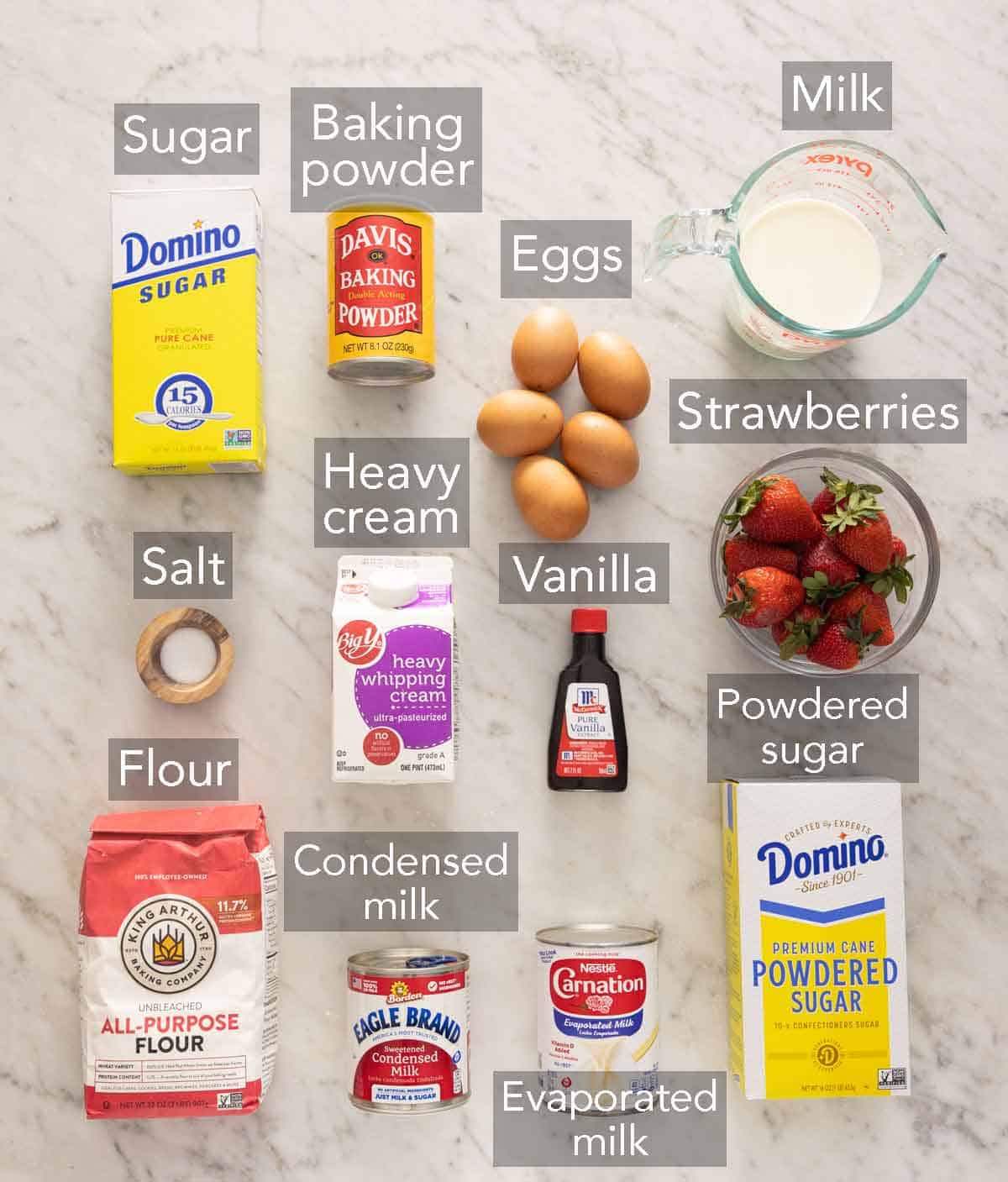
Flour — you just need all-purpose flour for the perfect texture and light cake.
Baking powder — baking powder helps the cake rise.
Eggs — you’ll need to separate the eggs, as the egg whites and egg yolks are prepared in different ways.
Sugar — granulated sugar adds the right amount of sweetness to the sponge cake.
Milk — whole milk adds moisture and richness to the cake.
Vanilla — use good vanilla extract for the best flavor.
Syrup — for the three-milk syrup, you need condensed milk, evaporated milk, and whole milk.
Frosting — the whipped cream frosting is beyond easy and only requires heavy whipping cream and powdered sugar.
How To Make Tres Leches Cake
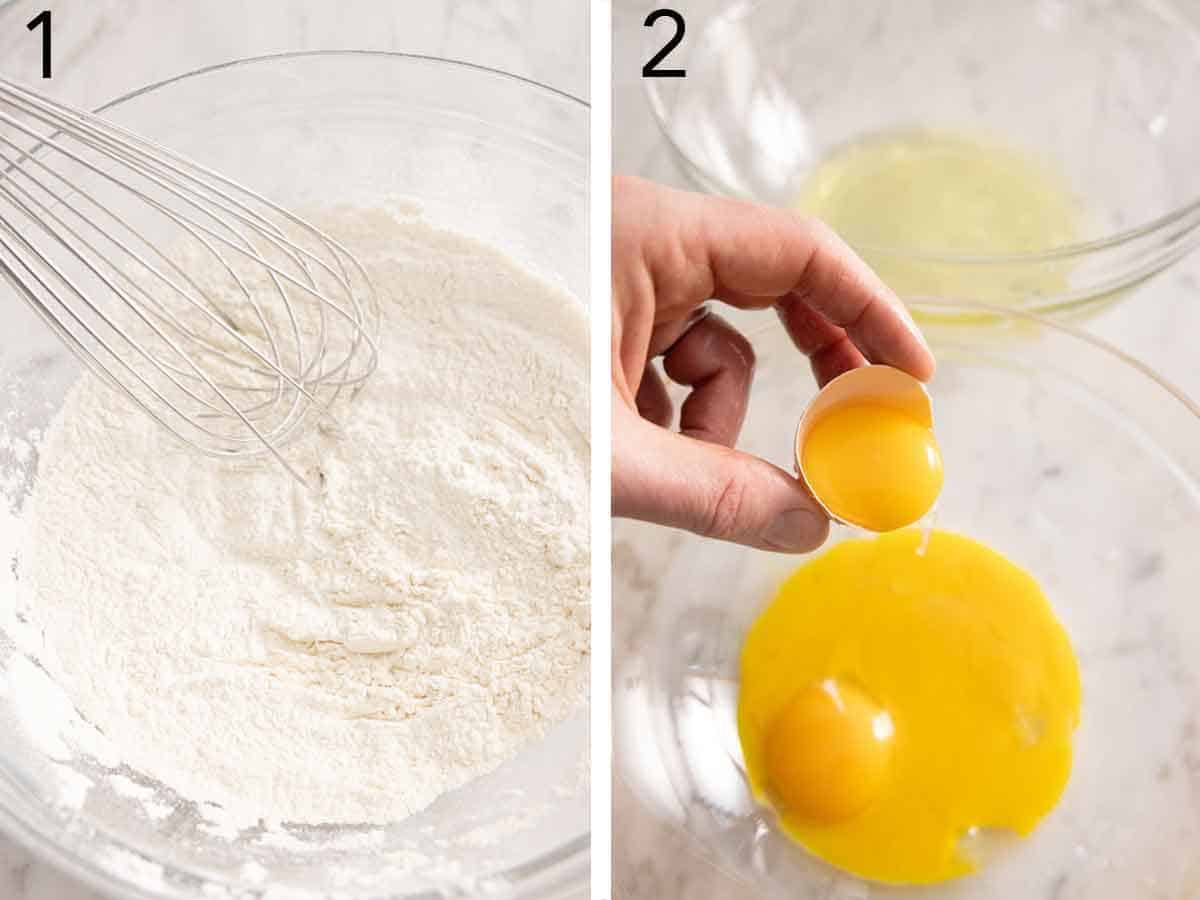
1. In a large bowl, whisk together the flour, baking powder, and salt. Set aside.
2. Separate the eggs into two separate bowls: a medium bowl for the yolks and a large bowl for the egg whites.
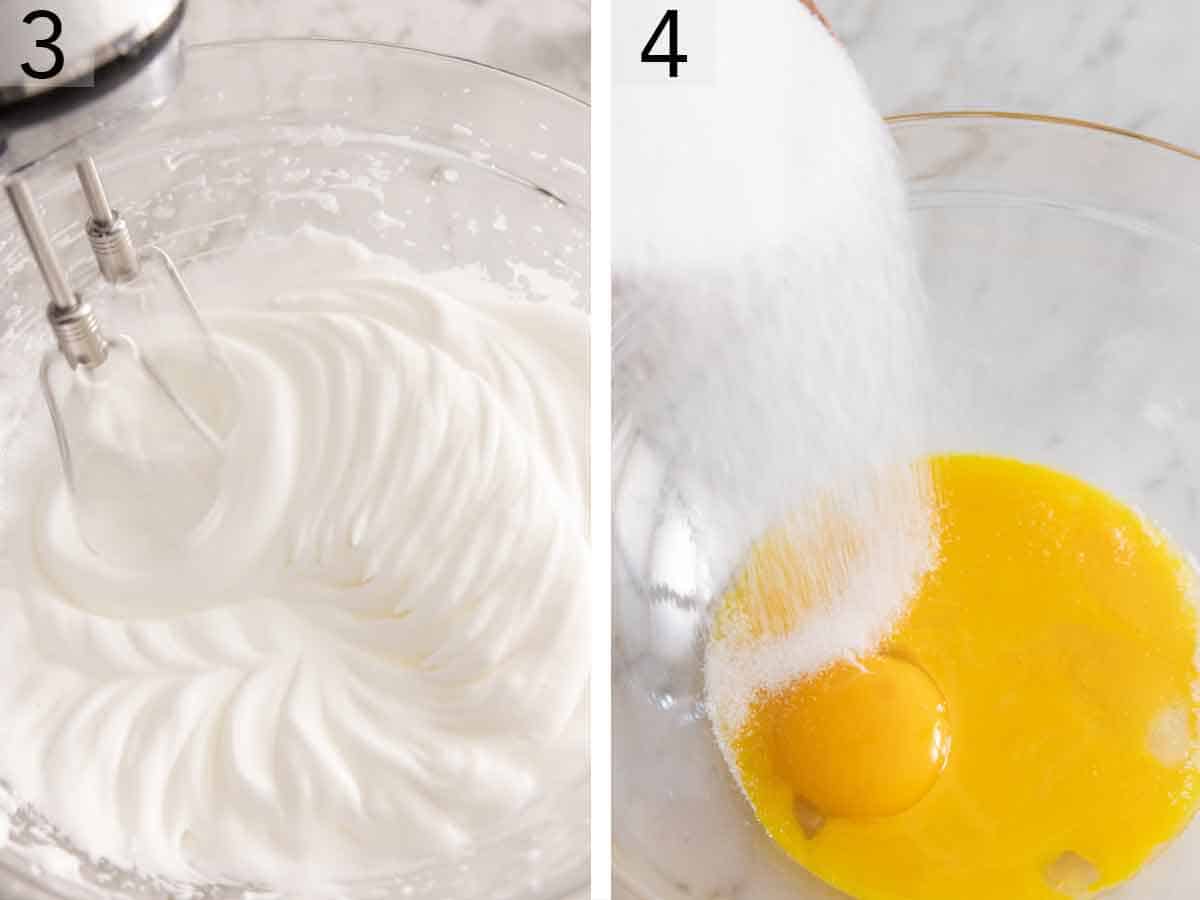
3. Using a hand mixer, beat the egg whites on high speed until foamy and doubled in size. While beating, slowly pour in ¼ cup white sugar. Continue beating until stiff peaks form, about 3 minutes. Set aside.
4. Add the remaining 1 cup sugar to the egg yolks and beat on medium speed until pale yellow and fluffy.

5. Beat the whole milk and vanilla extract into the egg yolk mixture.
6. Add the egg yolk mixture to the dry ingredients and beat just until combined.
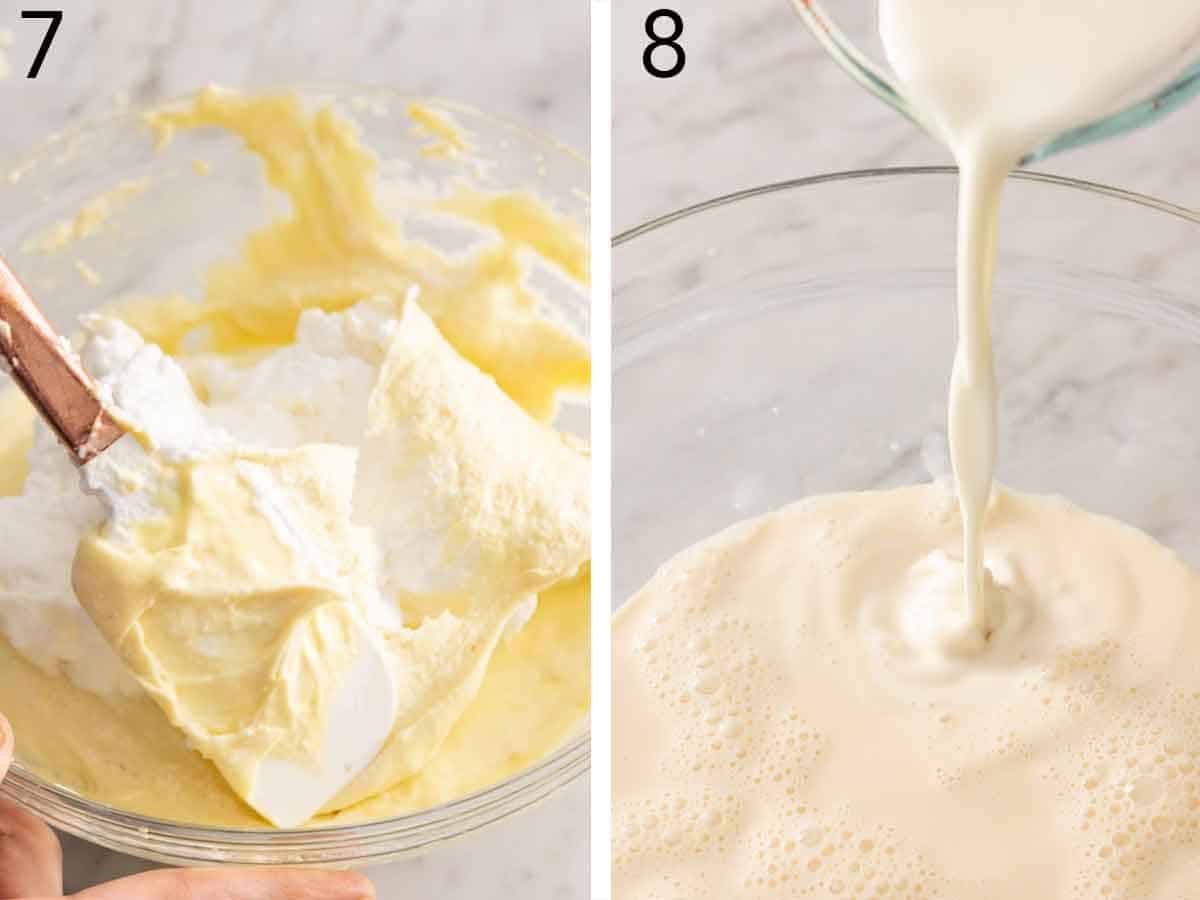
7. Using a spatula, fold the whipped egg whites into the flour mixture in two batches until no white streaks remain. Pour the tres leches cake batter into a buttered 13×9-inch cake pan. Bake at 350°F for 25 to 30 minutes or until a toothpick inserted into the center comes out clean.
8. Make the syrup by whisking together condensed milk, evaporated milk, and whole milk until well combined.
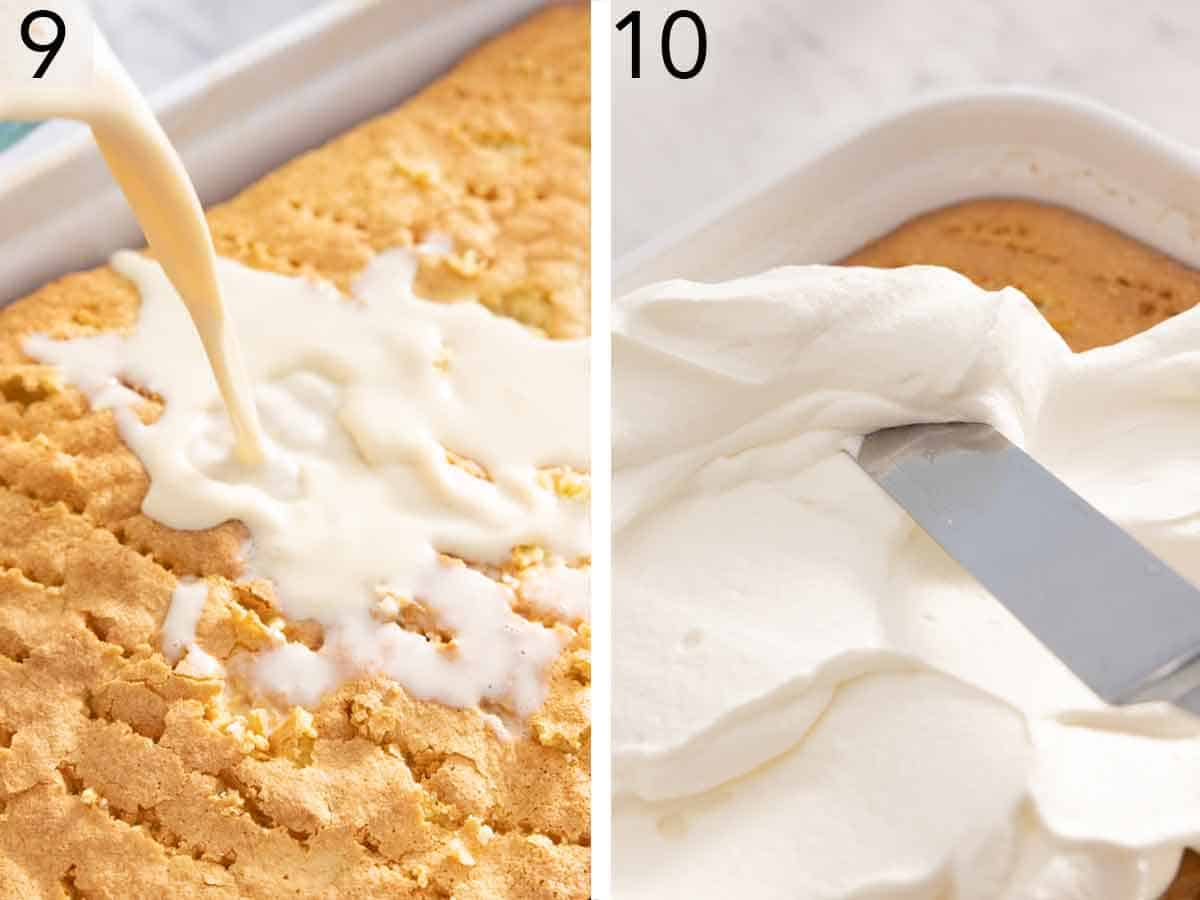
9. Poke holes all over the cake with a fork. Slowly pour the milk syrup over the cake. Cover and chill in the refrigerator for at least 1 hour.
10. Meanwhile, prepare the whipped cream frosting by beating the heavy cream and powdered sugar on medium speed until soft peaks form. Spread over the top of the cake before serving.
Why Did My Cake Shrink After Baking?
This is normal! The airy sponge cake will collapse slightly after baking and shrink into the pan and away from the sides. It will expand again like a sponge when soaked with the milk syrup.
Can I Bake This In A Different Pan?
You can make two smaller cakes by dividing the cake batter into two 8-inch square or round cake pans. Divide the syrup and topping between them.
I’ve been asked before if you can make this into a layer cake, and I don’t recommend it. My tres leches cake is very moist, so the soaked layers do not stack well.
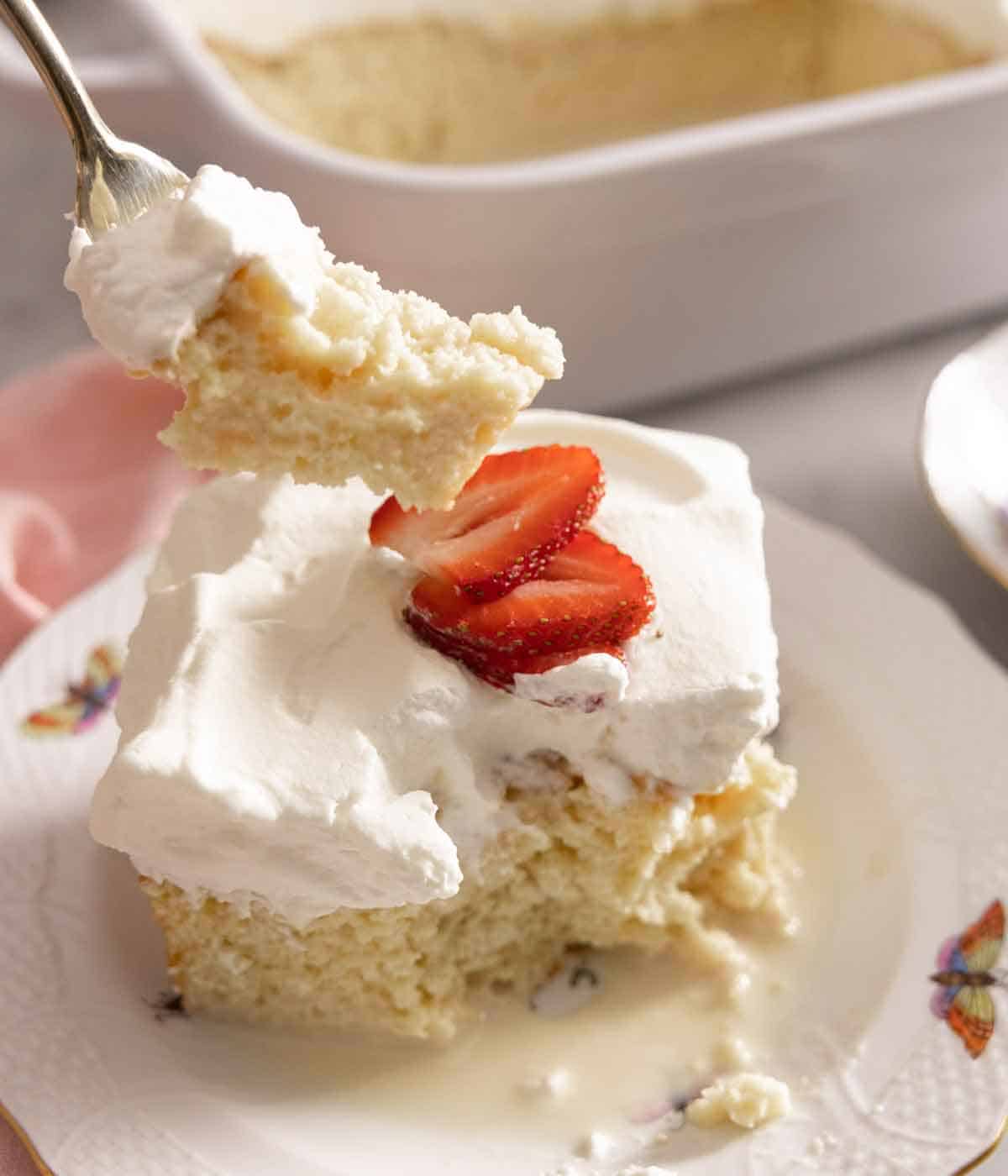
Can I Make This Ahead Of Time?
Yes! I actually recommend making tres leches cake a day in advance to give the cake ample time to soak up the syrup. 12 to 24 hours is ideal. Prepare and add the whipped cream frosting right before serving, as the frosting will start to deflate over time.
Pro Tips For Making This Recipe
- Use a scale to measure the flour. However, if you don’t have a scale, be sure to fluff your flour with a spoon and then spoon it into your cups before leveling it off with a knife. This method is the best way to measure flour without overpacking the measuring cup, leading to a dense cake.
- Separate the eggs while they are cold. Eggs are much easier to separate when cold, but egg whites whip up easier when closer to room temperature. I recommend separating the eggs in advance if you have the time so that the egg whites can come to room temperature.
- When whipping the egg whites, make sure there’s no water or oil in the bowl, as it will prevent the egg whites from forming peaks.
- Don’t deflate the whipped egg whites. When folding the egg whites into the flour mixture, turn the mixture in on itself with a cutting motion, not stirring. This way, you gently incorporate the egg whites and do not deflate them.
- Don’t overmix the batter. Otherwise, you’ll overdevelop the gluten and will end up with a tough cake.
- To pop air bubbles in the cake batter: Gently tap the cake pan on the counter a few times to pop any large air bubbles and level out the batter in the pan for an even bake.
- Topping ideas: Keep it simple. The sweet whipped cream frosting is enough, but if you like, you can add a sprinkle of cinnamon or sliced fresh strawberries on top.
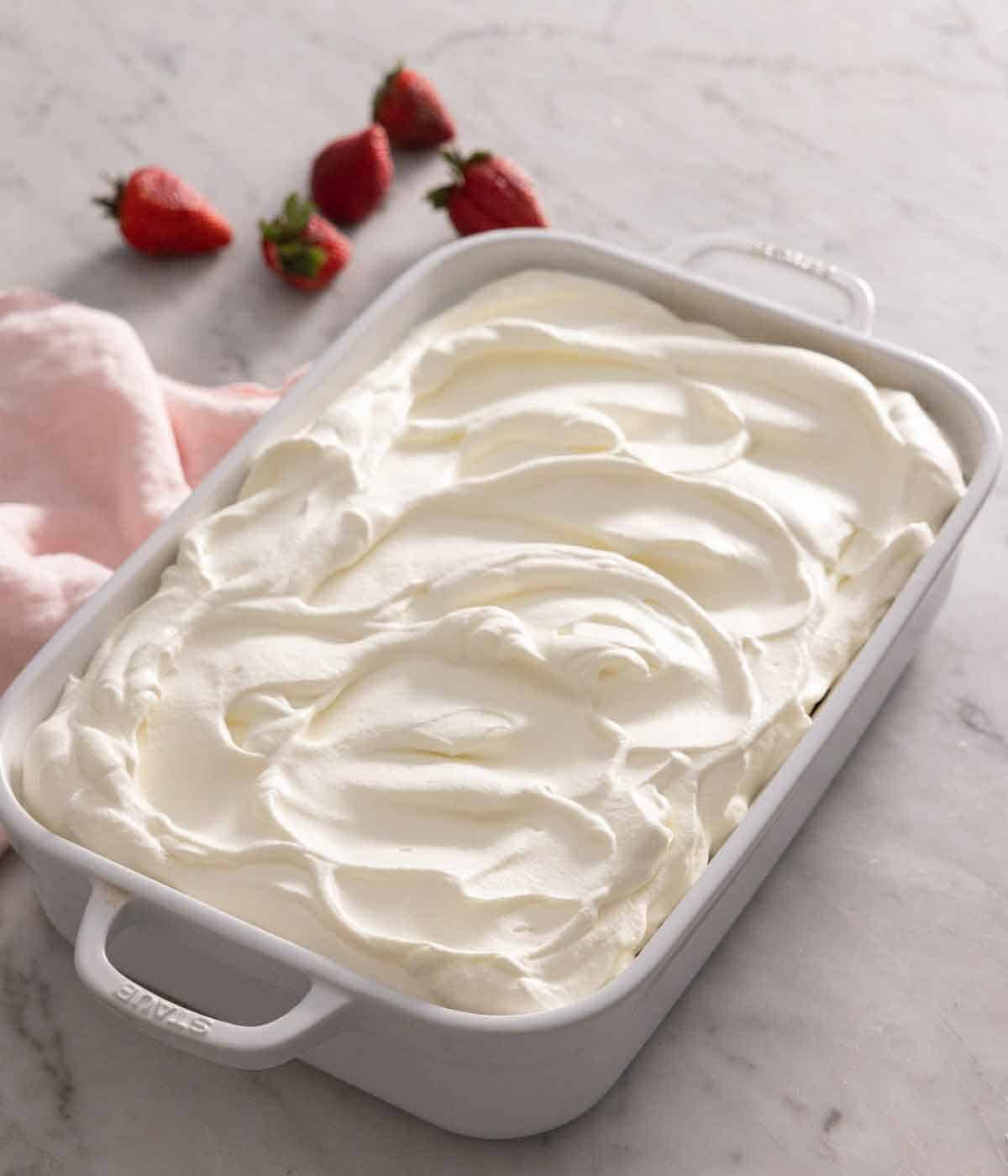
Frequently Asked Questions
Since the cake is soaked in milk syrup and topped with whipped cream frosting, it needs to be refrigerated, covered, or in an airtight container for up to 4 days. Tres leches cake is traditionally served cold, so there is no need to warm the cake or bring it to room temperature before serving.
You can freeze the plain cake before soaking and frosting it. Once it cools completely, wrap it tightly in plastic wrap and aluminum foil and freeze for up to 3 months. Thaw overnight before soaking it and adding the topping.
After the cake has been soaked in the milk mixture and topped with the frosting, I don’t recommend freezing it as it will be very soggy and less appetizing when it thaws out.
You can use an equal amount of whole milk or half and half to replace the evaporated milk in the syrup. I do not recommend substituting the condensed milk, as that will change the syrup’s flavor and consistency.
If you’ve tried this tres leches cake recipe, then don’t forget to rate it and let me know how you got on in the comments below. I love hearing from you!
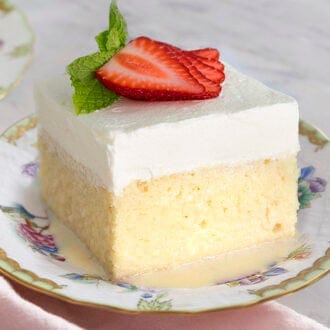
Tres Leches Cake Recipe
Video
Equipment
- Mixing Bowls
- Electric mixer or stand mixer
- Cake pan
Ingredients
For the Cake:
- 2 cups all-purpose flour (240g)
- ¾ teaspoon baking powder
- ½ teaspoon salt
- 5 large eggs
- 1¼ cup granulated sugar (250g)
- ½ cup whole milk (120ml)
- 2 teaspoons vanilla extract
For the Syrup:
- 1 (14-ounce/397g) can sweetened condensed milk
- 1 (12-ounce/354ml) can evaporated milk
- ⅔ cup whole milk (160ml)
For the Frosting:
- 2 cups heavy whipping cream (480ml)
- 2 tablespoons powdered sugar
- fresh berries for garnish
Instructions
For the Cake:
- Preheat the oven to 350F. Butter a 13×9-inch baking dish or spray with baking spray.
- In a large bowl, whisk together the flour, baking powder, and salt.
- Separate the eggs into two separate bowls, a medium one for the yolks and a large one for the white. Beat the egg whites on high speed until foamy and doubled in size, about 1 minute. While beating, slowly pour in ¼ cup sugar. Continue beating until stiff peaks form, about 3 minutes.
- Add the remaining 1 cup sugar to the egg yolks and beat on medium speed until pale and fluffy, about 1 minute. Beat in the milk and vanilla. Pour into the flour mixture and beat just until combined.
- Using a spatula, fold the egg whites into the flour mixture in two batches, until no white streaks remain. Pour the batter into the cake pan.
- Bake for 25 to 30 minutes or until a toothpick inserted into the center comes out clean. Let the cake cool until slightly warm. (The cake will fall and shrink as it cools. This is normal!)
For the Syrup:
- In a medium bowl, whisk together the condensed milk, evaporated milk, and whole milk until well combined. Poke the cake all over with a fork. Slowly pour the syrup over the cake. Cover and chill for at least 1 hour.
For the Frosting:
- In a large bowl, beat the cream and sugar on medium speed until soft peaks form. Spread over the cake. The cake can be covered and refrigerated for 3 days before serving. Garnish with strawberries, if desired.
Notes
- Use a scale to measure the flour. However, if you don’t have a scale, be sure to fluff your flour with a spoon and then spoon it into your cups before leveling it off with a knife. This method is the best way to measure flour without overpacking the measuring cup, leading to a dense cake.
- Separate the eggs while they are cold. Eggs are much easier to separate when cold, but egg whites whip up easier when closer to room temperature. I recommend separating the eggs in advance if you have the time so that the egg whites can come to room temperature.
- When whipping the egg whites, make sure there’s no water or oil in the bowl, as it will prevent the egg whites from forming peaks.
- Don’t deflate the whipped egg whites. When folding the egg whites into the flour mixture, turn the mixture in on itself with a cutting motion, not stirring. This way, you gently incorporate the egg whites and do not deflate them.
- Don’t overmix the batter. Otherwise, you’ll overdevelop the gluten and will end up with a tough cake.
- To pop air bubbles in the cake batter: Gently tap the cake pan on the counter a few times to pop any large air bubbles and level out the batter in the pan for an even bake.
- Topping ideas: Keep it simple. The sweet whipped cream frosting is enough, but if you like, you can add a sprinkle of cinnamon or sliced fresh strawberries on top.



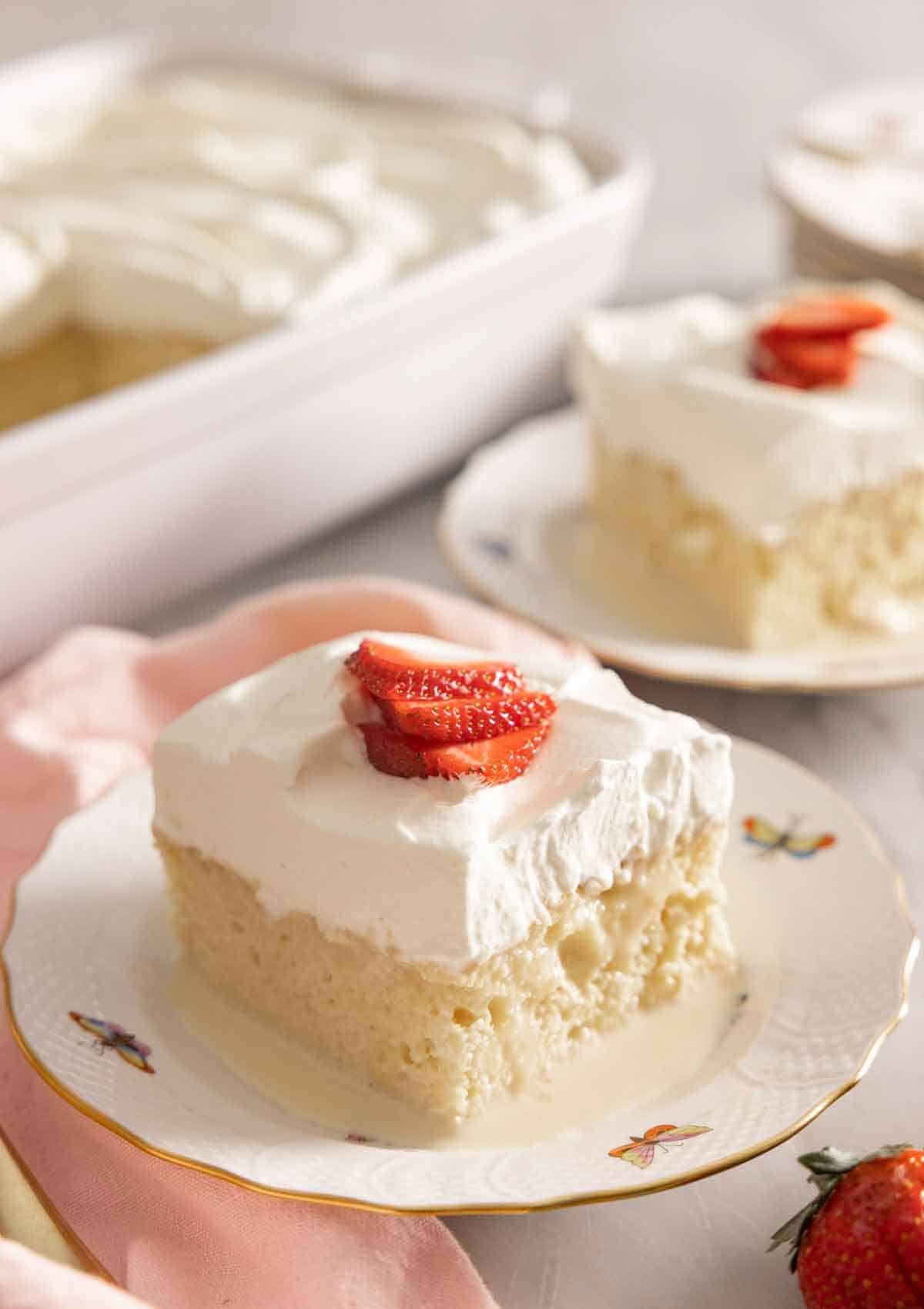
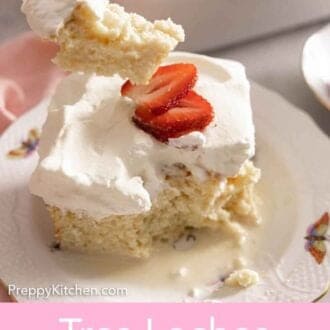
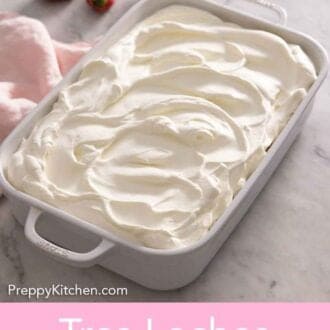
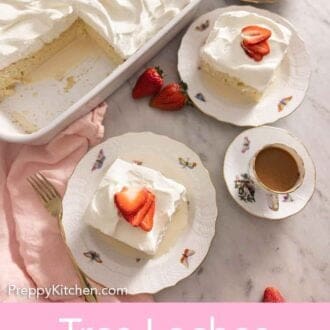

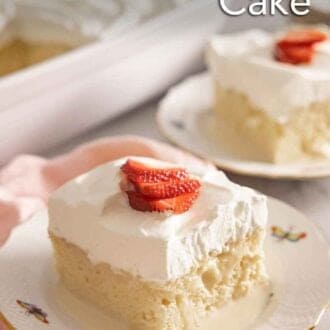
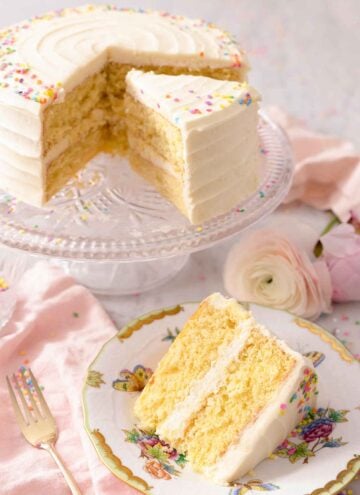

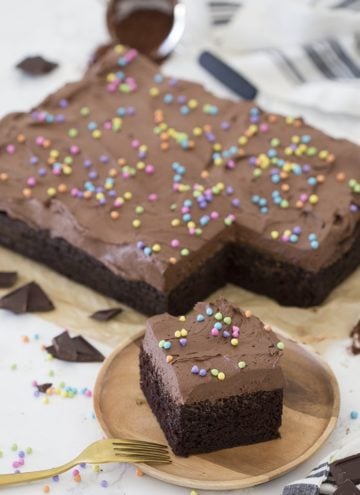



sadia says
how can i make the cake batter strawberry?
Sarah Ward (Executive Editor, Preppy Kitchen) says
A strawberry tres leches sound delicious! You could try processing a 2-ounce bag of freeze-dried strawberries in a food processor until it’s powdery. Then whisk that powder into the flour mixture. We haven’t tested this, but if you try it let us know how it turns out! It should add a tangy strawberry flavor to the cake batter.
Chrissy says
Amazing recipe and I loved following the along with it. Absolutely delicious!